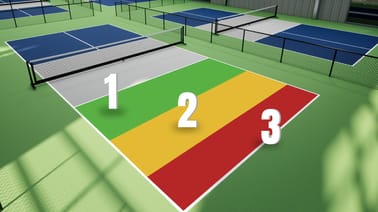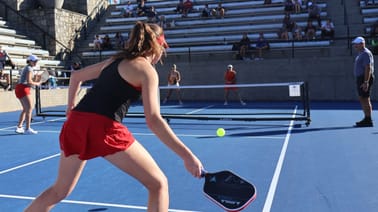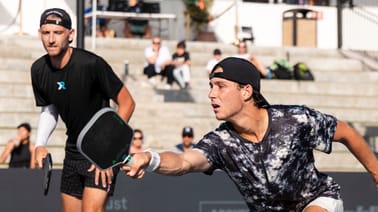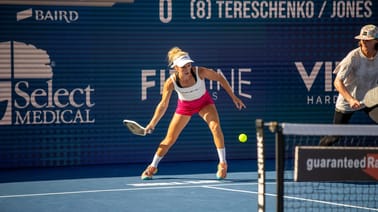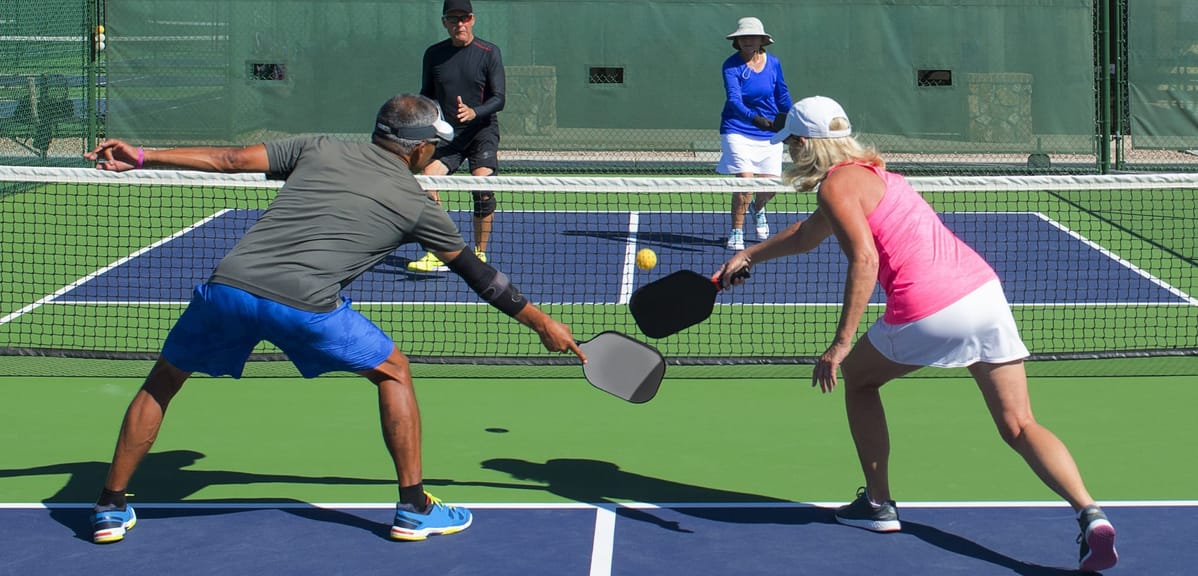
Batman and Robin. Peanut butter and jelly. Left side and right side doubles pickleball players.
The best duos in history work because they complement each other so well. Where one is flashy and gets all the "oohs" and "ahhs" (hello there Skippy creamy peanut butter), the other is rock solid and dependable.
Sign up today for the most informative newsletter in pickleball from The Dink!
Basically, every Batman needs a Collin Johns.
What makes each side different for doubles pickleball and what does it take for your team to become a delicious afternoon snack – or just play more cohesive pickleball games?
Glad you asked.
One note: Most of this applies to teammates that are same-handed (righty righty or lefty lefty) rather than teams with a left-handed player and a right-handed player. The dynamics obviously change a bit in that case.
Why Sides Matter – It's All About the Forehand
The power of the forehand cannot be understated.
Even if your forehand is trash, you can typically generate more power and better control with a forehand shot than you can a backhand one. Therefore, when we're discussing left side players vs right side players in a competitive match, you almost always want the person with the strongest forehand on the left side of the court. This is why teams "stack" their players, so that the stronger player is always on the left side.
If you need a quick lesson on stacking, ThatPickleballGuy has you covered.
If both players have equal forehands, then it may come down to shot making, comfortability, or creativity instead. We'll discuss this more further down.
The Pickleball Court is NOT 50/50
Take it from Collin Johns (watch, "YOU are playing pickleball wrong"), you must stop thinking of the pickleball court as 50/50. The center line, once the serve is done, really doesn't matter in doubles pickleball. It should be used as a guide, not a fence separating you and your partner.
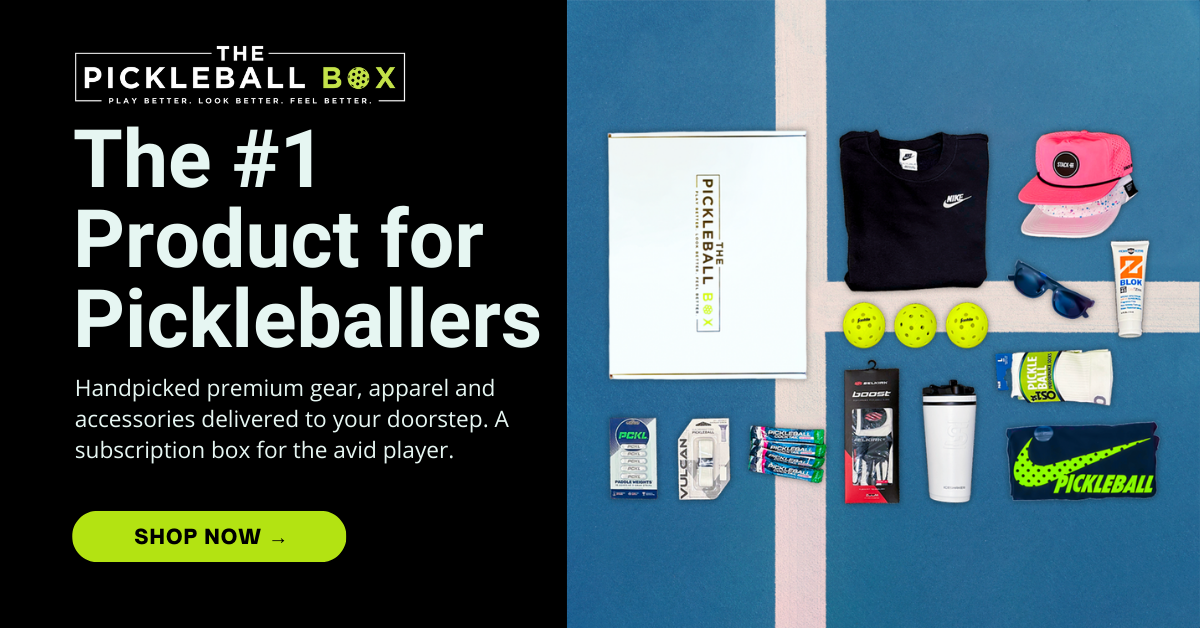
For $50 off your first Pickleball Box, use code Dink50.
How much of the court should each player get? Ultimately, it depends on the skill level of each player, and how much the right side player is willing to give up. For some it might be 52/48. For others, 70/30 is the perfect mix.
Where do you and your partner fit? That's something you'll need to work out as you play more together.
Now, let's get into playing each side of the pickleball court the right way.
Right Side Player Roles
"Steady Eddy," "The 30/40 percenter," and "Captain of the block party" – these are all proper nicknames for the right side player on a pickleball team. As a right-side player, your main role is to provide support and to setup your partner for winning shots. Yes, you will get the occasional putaway opportunity, but you better not miss.
Think of yourself as Steve Buscemi, Scottie Pippen, or Chewbacca. You may not get the glory, but everything works better because you're the most supportive teammate on the court.
Tools in Your Utility Belt
It takes a very special person to embrace the right-side role on a pickleball court. Your love language is probably acts of service and words of affirmation. You are excellent at customer service and making sure everyone is having a good time at a party.
You are a healing crystal in a world where everyone wants to be a diamond.
You're unique set of skills should include:
- Measured and consistent forehand dinks
- An ability to move the ball around and create space between your opponents
- Excellent blocking ability and resets
- Strong peripheral vision – for knowing when to get out of your partner's way
- Admiration and a desire to master the Collin Johns "Slide backhand"
Overall, consider it your job to keep points alive and buy your playmaking partner all the time they need to win the rally. When you do get an opportunity to shine, enjoy it. But, then get back to the small corner of the court you're allowed to play on.
Notable Right Side Pros
You can't talk about right side pros without mentioning the right-side GOAT – yes, we're talking Johns. Collin Johns. Whether you love him or you're just like, meh, there is no denying his commitment to playing downwind of his brother. He has all the skills he needs for that side of the court and they have been spammed up to level 100.
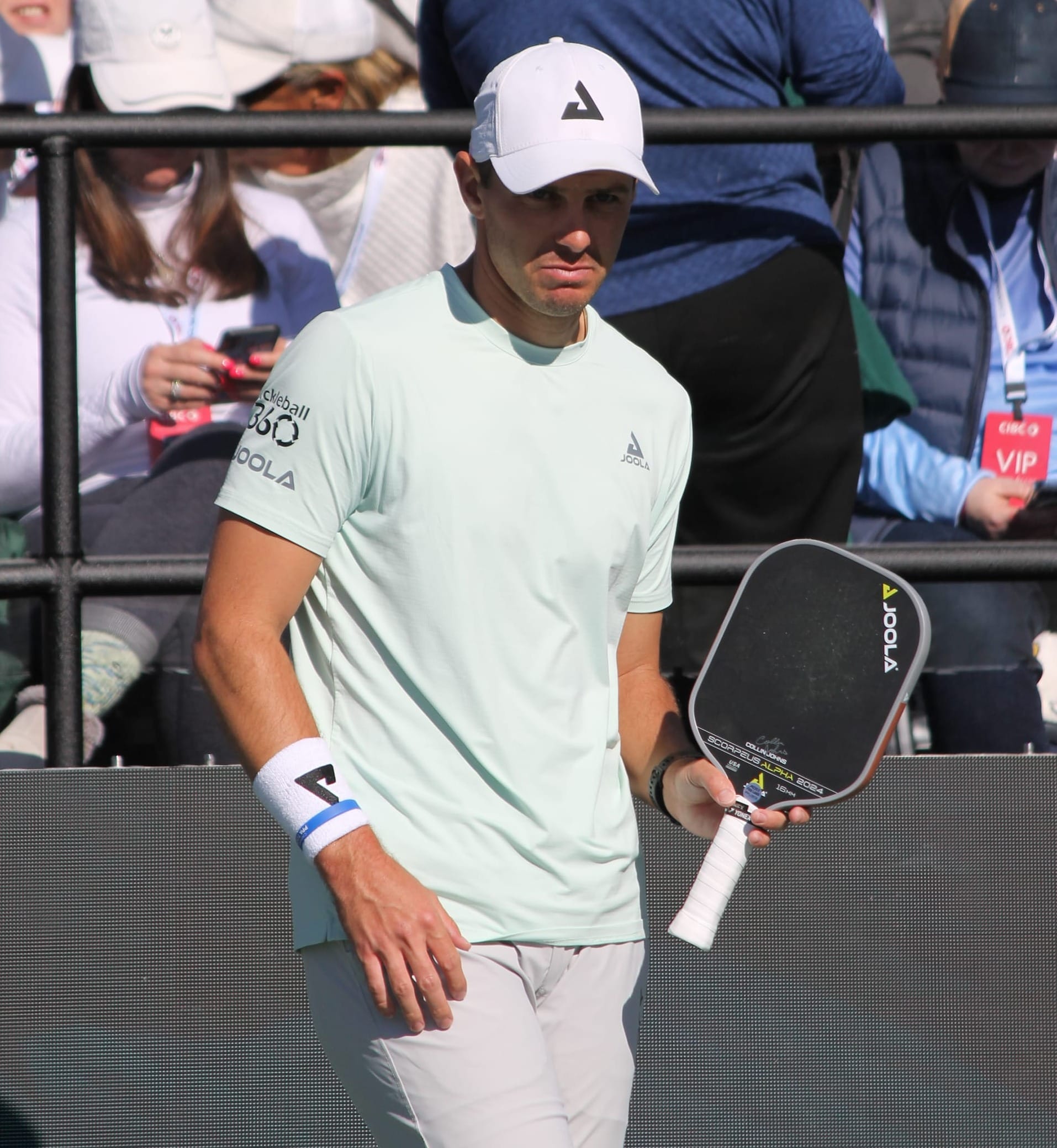
Other notable right siders, include:
- Susannah Barr – Plays mostly alongside Megan Fudge and Andrei Dăescu on the APP Tour. Susannah is committed to her craft and is a great professional player.
- Dylan Frazier – Men's doubles partner to JW Johnson on the PPA Tour. Dylan is too good to stay on the left side of his best friend for much longer, though.
- Thomas Wilson – Riley Newman's partner on the PPA Tour. His forehand is good enough to push Riley out of the way sometimes.
- Jade Kawamoto – Jade is left-handed and her sister, Jackie, is right-handed and it's fun to watch when they play together. The sisters play on the PPA Tour, but also spent some time on the same MLP team last year.
Left Side Player Roles
"The Playmaker," "Poach King (or Queen)," and "Mine." If these are your nicknames, you are a left side player. As such, it's your job to win your team games. You command the bulk of the court not because your greedy, but because it just makes sense.
You are Denzel, Captain Kirk, or Beyonce. When your team wins, you likely had the game-winning shot. If your team loses, well that's your fault, too. Do better next time.
The Tools in Your Utility Belt
No one is just given the keys to the Ferrari forehand. As a left-side player, your weapons need to be sharp and biting, but you must also be willing to fail sometimes from taking too big of a risk. Misses need to be few and far between.
To be a dominant left side player, master these skills:
- Fantastic footwork
- Fourth-shot rolls
- Lots of backhand dinks
- Find your forehand, every chance you get
- It's called a putaway for a reason – make it count
- Learn the Shake-n-Bake, and be able to shake your own bake once in a while
Overall, it's your job to be the middle court meastro and dictate everything that comes over the net. When the other team makes a mistake, you punish them. Just remember, it's not about you or your ego, it's about doing what it takes for your team to win. You might get the glory, but you must also be willing to take the blame.
Notable Left Side Pros
Similar to his brother, if there is a player built for a specific side of the court, it’s Ben Johns and the left side. Hands down, no one is better. He has all the shots, the creativity, and can absolutely dominate any time he wants.
Notable left siders, include:
- Riley Newman – You can’t talk left side or court coverage without mentioning Newman. The only question is will he and Thomas Wilson become the team that unseats the Johns bros at the top?
- Anna Leigh Waters - The most dominant female pickleball player in the world. Her and Catherine Parenteau’s run is truly unbelievable and, when it finally gets broken, may be something we never see again.
- JW Johnson – If you want to watch dominance wrapped in nonchalance (and sweatpants), then J-Dubs is your guy. He has the nastiest wrist flick in pro pickleball.
- Etta Wright – Etta missed a lot of time over the last year due to injury. But now she’s back and healthy and reminding everyone that she’s a force to be reckoned with.
Tips for Playing Both Sides
Of course, these descriptions are only scratching the surface of doubles strategy. No matter which side you play on, consider these tips to have more success and enjoy pickleball even more.
Communication Over Everything
Players on both sides need to communicate clearly. "Yours" or "Mine" can go a long way into helping you both establish who takes each individual shot and also help you build rapport if you play together again.
Over-communication can also reduce the chance of injury, which is an often overlooked benefit.
It's About Skillsets; Not "Who is Better"
There is a misconception that the better player is always on the left and the weaker is on the right.
While that may be true when there is a big gap in skills, it's not necessarily when that gap is small. Instead of thinking in terms of "who is better," consider whose skillset fits each side. If you like playing with your backhand, play the right side (if you're right handed). If it benefits your team to maximize your forehand chances, play on the left side.
Use Rec and Open Play to Improve on Both Sides
You can't improve if you don't practice. Unless there's a very strong case to do so, open and recreational players should not be stacking. Those games are perfect for trying out both sides of the court, because wins and losses don't matter.

However, that doesn't mean you shouldn't communicate and play each side "the right way" when you're on it and encourage your partner to do the same.
Try this: Next time you’re in a rec game, start on the right side and draw a vertical line for your partner (assuming they are right-handed), showing them exactly how much court the left-side player can have. This will reduce confusion and not allow any of those pesky middle balls to go unpunished. When you're on the left side, you should be given the same amount of coverage.
A Note on Lefty/Righty Teams
According to Ben Johns and several other experts on the game, the future of pickleball is having a lefty and a righty on each team. This makes sense because it allows for two forehands in the middle, which is where the majority of balls are hit.
But just because you have two forehands doesn't mean you don't have to communicate or concede to the other player sometimes.
With a lefty/righty combo comes some nuances that are beyond this article (Keep an eye out for a lefty-righty strategy article later this week).
But, mostly, it's about getting comfortable with the other player and learning which shots they like to take and which make more sense for you to take. In a lefty/righty combo, the player on the left side (right handed) can play more like a "right side" player described above and vice versa.
If the lefty has a better forehand, give up some of the middle. It should be about whatever is best for the team, not what's best for your ego.
Mixed Doubles
At the pro levels, the female always plays the right side and the male always the left side. You are not a pro. If you're playing with the opposite sex, put your ego to the side and worry about playing well, not taking (or conceding) every ball because that's "what the pros do."
If you have a mixed-doubles partner, I'm confident you can both work out how much court each of you should command ahead of a tournament or league match. In rec play, being born with different bits doesn't mean you have to play one side or the other.
If you find yourself in an uncomfortable situation or you just can't play with the opposite sex, then politely remove yourself from that rotation and wait for someone you do feel comfortable playing with.
If you do want to get better at mixed doubles, communicate throughout your match together. No partnership ever ended because one partner communicated too well.



